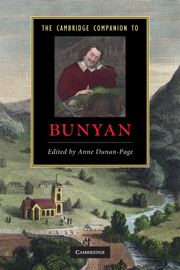Book contents
- Frontmatter
- Introduction
- Part I John Bunyan in his seventeenth-century context
- Part II John Bunyan’s major works
- 5 Grace Abounding to the Chief of Sinners: John Bunyan and spiritual autobiography
- 6 The Pilgrim’s Progress and the line of allegory
- 7 Bunyan and the early novel: The Life and Death of Mr Badman
- 8 Militant religion and politics in The Holy War
- 9 A Book for Boys and Girls: Or, Country Rhimes for Children: Bunyan and literature for children
- Part III Readership and reception
- Guide to further reading
- Index
7 - Bunyan and the early novel: The Life and Death of Mr Badman
from Part II - John Bunyan’s major works
Published online by Cambridge University Press: 28 July 2010
- Frontmatter
- Introduction
- Part I John Bunyan in his seventeenth-century context
- Part II John Bunyan’s major works
- 5 Grace Abounding to the Chief of Sinners: John Bunyan and spiritual autobiography
- 6 The Pilgrim’s Progress and the line of allegory
- 7 Bunyan and the early novel: The Life and Death of Mr Badman
- 8 Militant religion and politics in The Holy War
- 9 A Book for Boys and Girls: Or, Country Rhimes for Children: Bunyan and literature for children
- Part III Readership and reception
- Guide to further reading
- Index
Summary
The Pilgrim's Progress has played a critical role in the development of the English novel, and one need look no further than Daniel Defoe's Robinson Crusoe (1719) to see how it provided both structural and thematic inspiration for the early novelists. Anyone teaching a course on the rise of the novel will make this connection, emphasising the many correspondences that exist between the two works and tracing the line that leads, for example, from Giant Despair in The Pilgrim's Progress (1678) to Island Despair in Robinson Crusoe. Nonetheless, the point always needs to be made that The Pilgrim's Progress is not a novel, and that its allegorical nature aligns it with an earlier tradition of prose fiction than Defoe's. As Ian Watt would say, it lacks 'formal realism': the patina of circumstantial and referential detail that distinguishes Defoe from his immediate literary predecessors, helping to establish what we now generally think of as the 'early novel'. Bunyan's landscape is not Defoe's real world where a protagonist can make his way from York to London, and ultimately to North Africa, Brazil and the Caribbean, rather than from the City of Destruction to the Celestial City by way of the Valley of the Shadow of Death and Vanity Fair (even if Bunyan clearly drew on his knowledge of the Bedfordshire countryside and London to construct that landscape). To identify a lack of novelistic realism is not to denigrate The Pilgrim's Progress, which stands as one of the greatest works of English and indeed of world literature. Far more than a proto-novel, it has provided inspiration for generations of readers through the years in their own struggles against adversity and repressive authority.
- Type
- Chapter
- Information
- The Cambridge Companion to Bunyan , pp. 95 - 106Publisher: Cambridge University PressPrint publication year: 2010
- 1
- Cited by

